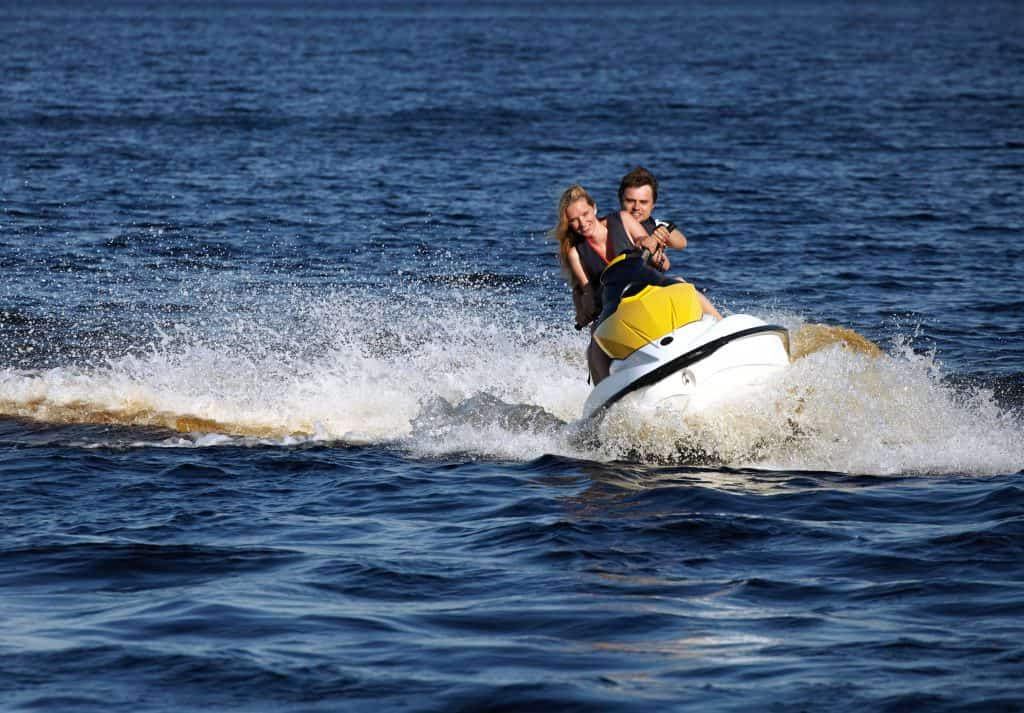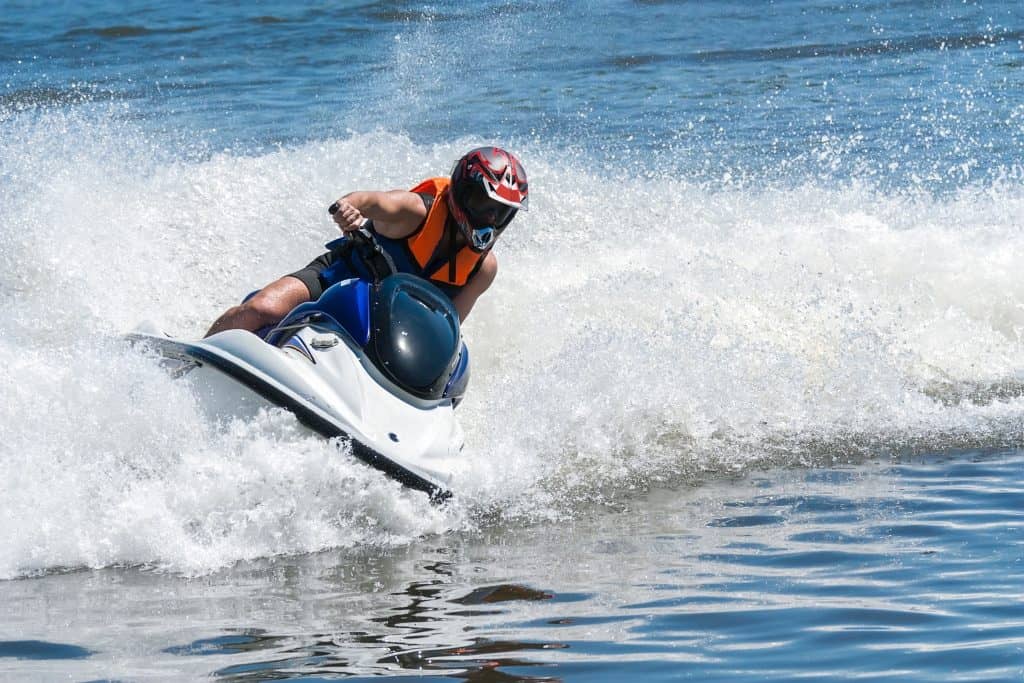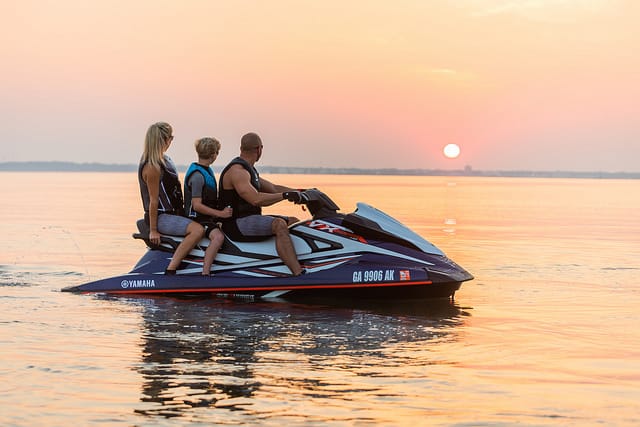Jet skis are a great way to spend time on the water in the summertime and create some memorable times with family and friends. In order to have a great time, you will need to know the laws for riding a jet ski according to the state you reside in. Rules and regulations can vary from state to state and it is a need-to-know in order to be able to enjoy your time on the water.
Within the state of Arizona, anyone under the age of 12 is not allowed to operate a PWC or water vessel with horsepower greater than 8 horsepower. Tough the exceptions are if: there is an emergency, an adult is also one board (parent or legal guardian), or if there is another person on board that is 18 years of age or older.

The Basics
PWC Rules and Regulations
- Each person on the PWC has to wear a PFD type 1, 2, or 3 and it must also be approved b the U.S. Coast Guard.
- The safety ignition switch must be fully functional and have a lanyard attached to it to ensure it does not get lost or misplaced.
- You must have a whistle or horn on board your PWC that is also U.S. Coast Guard approved.
- You cannot remove any backfire flame arrestor or ventilator if it is installed by your manufacturer.
- It is illegal to operate a personal watercraft vehicle between the hours of sunset and sunrise especially when your vision is a bit restricted.
- You cannot operate a PWC within 500 feet of a designated swimming area.
- Reckless operation of your PWC is not allowed. Examples of this are:
- If you maneuver your PWC in a way that causes harm to others or your passengers
- Last minute avoidance of collision
- weaving carelessly through vessel traffic
- Jumping a wake too close to other vessels
- Carrying more passengers on your PWC than is recommended
Alcohol and Drugs
Being under the influence while boating is a reckless and dangerous thing to do. By doing so you are not only putting yourself in danger but those riding your PWC or vessel and those around your vessel and PWC.
- Anyone over the age of 21 cannot operate a PWC if their blood alcohol concentration is 0.08% or greater, or if drugs are detected they are also prohibited from operating a PWC
- If anyone is convicted of having a blood alcohol concentration greater than 0.15% it is considered to be “Extreme OUI”, and with that, you can be fined up to $2,500 and be jailed for up to six months
- You can carry more severe penalties if you are convicted of “Aggravated OUI”
Reckless Operation of Your PWC
Failure to Regulate Your Speed
When you operate your vessel at a faster speed than recommended you are putting those around you and yourself in danger. Especially during vessel traffic, poor weather conditions, and closeness to shore you will need to follow the speed regulation.
Examples of this are:
- operating your vessel at extreme speed in the close vicinity of another vessel, PWCs, or dangerous waters
- operating at a greater speed than “slow, no wake speed” that is posted in a “no wake” zone
- going faster than the speed limit posted near the body of water you are operating on
- going at a speed that can be harmful to your vessel
Improper Distance Between Others
If you are operating your vessel faster than 5 mph while operating within 100 feet of the shore, dock, pier, raft, float, or an anchored or moored vessel you are operating your vessel improperly and putting others around you at risk.
Unsafe Conditions
Not having enough PFDs, fire extinguishers, backfire flame arrestors, ventilation systems or navigational lights are putting yourself and others at risk.
You also put yourself and others in danger when you overload or overpower your boat, or when you are operating the vehicle while intoxicated.
Reckless Operation Specifics
This when you weave through traffic, swerve last minute to avoid a head-on collision with other vessels, or even overload your vessel beyond the recommended capacity.
Riding on the Bow, Deck, or Gunwale of a Vessel
Riding on anything that is not equipped with fixed seating can lead to the potential of falling overboard into the water. Do not allow any of your passengers or even yourself to sit on the seat backs, transom, gunwale or on the seats on raised decks or a bow.

Registering Your PWC
Arizona Registration Fees
Resident
| LENGTH OF WATERCRAFT | REGISTRATION FEE |
| 0 to 12 ft. | $20.00 |
| 12 ft. 1 in. to 16 ft. | $22.00 |
| 16 f.t 1 in. to 20 ft. | $30.00 |
| 20 ft. 1 in. to 26 ft. | $35.00 |
| 26 ft. 1 in. to 39 ft. | $39.00 |
| 39 ft. 1 in. to 64 ft. | $44.00 |
| 64 ft. 1 in. and over | $66.00 |
Non-Resident
| LENGTH OF WATERCRAFT | REGISTRATION FEE | NON-RESIDENT BOATING INFRASTRUCTURE FEE | TOTAL |
| 0 to 12 ft. | $20.00 | $80.00 | $100.00 |
| 12 ft. 1 in. to 16 ft. | $22.00 | $88.00 | $110.00 |
| 16 f.t 1 in. to 20 ft. | $30.00 | $192.00 | $222.00 |
| 20 ft. 1 in. to 26 ft. | $35.00 | $224.00 | $259.00 |
| 26 ft. 1 in. to 39 ft. | $39.00 | $253.00 | $292.00 |
| 39 ft. 1 in. to 64 ft. | $44.00 | $286.00 | $330.00 |
| 64 ft. 1 in. and over | $66.00 | $429.00 | $495.00 |
Numbers and Stickers
Once you receive your registration number and the validation stickers you must display these items in the following ways:
- There cannot be any other numbers shown on the bow of your vessel
- The letters have to be separated from the numbers with space or hyphen
- Each number has to be painted, applied onto your vessel as a decal, or place to be shown on both sides of the bow
- The numbers must be read from left to right on both sides
- Each number must be in block letters and three inches high
- The color of your numbers must also be in contrast to the color of your vessel
Hull Identification Number
A Hull Identification Number (HIN) is a 12-digit number that s assigned by the manufacturer to vessels built after the year 1972. HIN help be able to determine the differences between multiple vessels.
In case your vessel is stolen you should write down your HIN number and out it somewhere safe.

Required Equipment
Personal Flotation Devices
| Type 1 | Offshore Life Jackets | This vest can turn an unconscious person in the water to face up in the water. It was made for rough waters and for situations where rescue might take a long time. |
| Type 2 | Near-Shore Vests | This vest is fit for calmer waters and faster rescues. If you were to wear this while unconscious it may not be able to turn your face up in the water. |
| Type 3 | Flotation Aids | This vest can also be a full-sleeved jacket and it is great for calm waters and fast rescues. This will definitely not turn your face up in rough waters. This is generally worn for water sports. |
| Type 4 | Throw able Devices | This type of flotation device is a cushion or ring buoys and are typically used to throw at someone in trouble. They are not made to last for long hours in the waters, or non-swimmers, or the unconscious. |
| Type 5 | Special-Use Devices | This type of flotation device was made for activities like kayaking, water-skiing These typically look like white water vests, deck suits, and personal flotation device hybrids. |
Fire Extinguishers
You can identify the type of fire extinguisher you have by looking at the letter and number symbol. The number helps you decipher the size of the extinguishers, and the letter indicates the type of fire that is extinguished as well.
TYPE A FIRES | These type of fires are combustible solids such as wood |
| TYPE B FIRES | These types of fires are flammable liquids like gasoline or oil |
| TYPE C FIRES | This type of fire is mainly electrical fires |
All vessels are legally required to have a Type B fire extinguishers on board your vessel in case of any extreme or dangerous situations occurring.
Your fire extinguisher should be placed somewhere easily accessible in the case of a situation where it needs to be used immediately.
What To Do In a Boating Accident
In the event of a boating or PWC accident you must do the following:
- Stop the vessel immediately and safely
- Assist the person who was injured and assess the injuries they have gotten
- Give in writing the name of the person, their address, and the vessel identification number to the owner of the property that was damaged
- To report an accident you can contact the sheriff’s or harbormaster’s office or any other police department.
Law Enforcement
According to the law of the state of Arizona county deputy sheriffs, municipal officers, park rangers, Arizona Game and Fish Department officers, and any other law enforcement officer are allowed to enforce the laws.
They have the power to stop your vessel if they feel that they have enough evidence to do so. In order to avoid any potential fines follow the guidelines below:
Carry the Card: Anyone operating a PWC and has completed the boater education course must carry the card they received while they are on the PWC at all times. This is to ensure they have it available in the case they are stopped for inspection by an officer.
Penalty: If you do not carry your boater education card with you while riding a PWC and you are stopped by an office you are likely to receive a fine.
